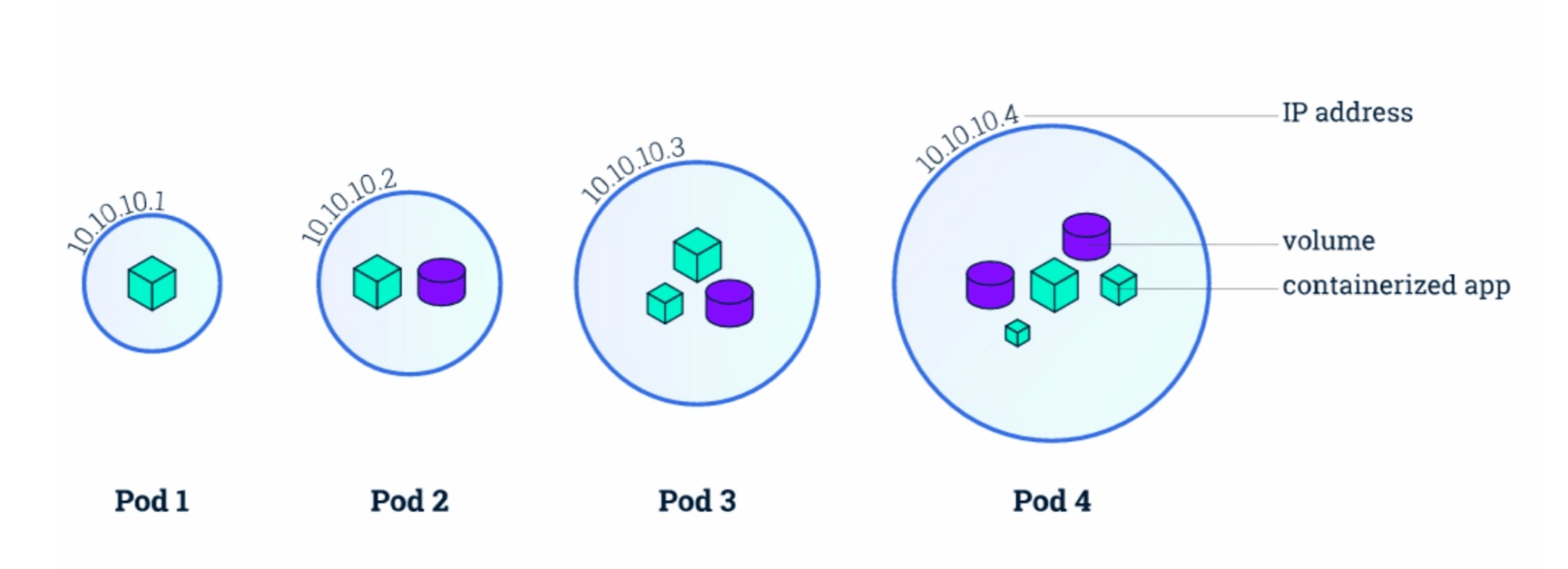[云原生微服务架构](十四) Kubernetes的pod
前面的系列文章已介绍kubernetes架构,安装,升级和快速入门,读者通过文章的实操已对kubernetes已有初步的认识和理解,从本章开始逐步介绍kubernetes中的基础概念概念和核心概念,基础概念包括:namespace,labels,annotations,pods,volumes等;核心概念包含kubernetes中各种controller,包含以下几种:
- 应用副本控制器有:Deployments,ReplicaSets,DaemonSets,StatefulSets;
- 批处理任务控制器Jobs和CronJob
- 存储控制器PersistentVoloume,PersistentVolumeClaim,StorageClass;
- 服务负载均衡Service,Ingress,NetworkPolicy和DNS名称解析;
- 配置和密钥ConfigMaps和Secrets
本文从最基础的概念pod开始讲解,后续逐步介绍应用部署,存储,负载均衡等相关的控制器,kubernetes内部由多个不同的控制器组成,每个控制器完成不同的功能。
1. 深入学习pod
1.1 Container和Pod概念
容器是一种便携式,轻量级别的容器虚拟化技术,使用linux cggroup技术实现各种资源的隔离,如cpu,memory,pid,mount,IPC等,相比于虚拟化技术如KVM,容器技术更加轻量级,它的产生主要解决环境的环境发布的问题,目前主流的容器技术是docker,说到容器,一般都等同于docker。
要运行容器首先需要有镜像,应用和应用依赖的环境运行在容器中,在kubernetes中不会直接运行container,而是运行pod,一个pod里面包含多个container,container之间共享相同的namespace,network,storage等。镜像存储在私有镜像或者公有镜像中,运行时通过docker image pull的方式拉取到本地运行,images的拉取策略包含有两种:
- ImagePullPolicy为Always,不管本地是否有直接下载
- ImagePullPolicy为IfNotPresent,默认镜像拉取得策略,本地不存在再拉取
Pods是kubernetes中最小的调度单位,Pods内运行一个或者多个container,container之间共享pod的网络ip资源,存储volume资源,计算等资源,方便pod内部的container之间能够实现快速的访问和交互。

Pod概念介绍
如上图所示,Pod的使用方式通常包含两种:
- Pod中运行一个容器,最经常使用的模式,container封装在pod中调度,两者几乎等同,但k8s不直接管理容器
- Pod中运行多个容器,多个容器封装在pod中一起调度,适用于容器之间有数据交互和调用的场景,如app+redis,pod内部共享相同的网络命名空间,存储命名空间,进程命名空间等。
1.2 如何创建pod
kubernetes交互的方式通常分为四种:
- 命令行,kubectl和kubernetes交互,完成资源的管理,命令行入门简单,但只能支持部分资源创建
- API,通过resfulAPI以http的方式和kubernetes交互,适用于基于API做二次开发
- SDK,提供各种语言原生的SDK,实现各种语言编程接入
- YAML,通过易于理解的YAML文件格式,描述资源的定义,功能最丰富,最终转换为json格式
kubernetes中通过定义生申明式的方式定义资源,即通过在yaml文件中定义所需的资源,kubernetes通过controller-manager按照yaml文件中定义的资源去生成所需的资源(match the current state to desired state)。通常在kubernetes中通过yaml文件的方式定义资源,然后通过kubectl create -f 文件.yaml的方式应用配置,如下演示创建一个nginx应用的操作。
1、编写yaml文件,定义一个pod资源
[root@node-1 demo]# cat nginx.yaml
apiVersion: v1
kind: Pod
metadata:
name: nginx-demo
labels:
name: nginx-demo
spec:
containers:
- name: nginx-demo
image: nginx:1.7.9
imagePullPolicy: IfNotPresent
ports:
- name: nginx-port-80
protocol: TCP
containerPort: 80复制
关于配置文件,说明如下:
- apiVersion api使用的版本,kubectl api-versions可查看到当前系统能支持的版本列表
- kind 指定资源类型,表示为Pod的资源类型
- metadata 指定Pod的元数据,metadata.name指定名称,metadata.labels指定Pod的所属的标签
- spec 指定Pod的模版属性,spec.containers配置容器的信息,spec.containers.name指定名字,spec.containers.image指定容器镜像的名称,spec.containers.imagePullPolicy是镜像的下载方式,IfNotPresent表示当镜像不存在时下载,spec.containers.ports.name指定port的名称,spec.containers.ports.protocol协议类型为TCP,spec.containers.ports.containerPort为容器端口。
2、创建pod应用
[root@node-1 demo]# kubectl apply -f nginx.yaml
pod/nginx-demo created复制
3、访问应用
获取容器的IP地址
[root@node-1 demo]# kubectl get pods -o wide
NAME READY STATUS RESTARTS AGE IP NODE NOMINATED NODE READINESS GATES
demo-7b86696648-8bq7h 1/1 Running 0 8h 10.244.1.11 node-2 <none> <none>
demo-7b86696648-8qp46 1/1 Running 0 8h 10.244.1.10 node-2 <none> <none>
demo-7b86696648-d6hfw 1/1 Running 0 8h 10.244.1.12 node-2 <none> <none>
nginx-demo 1/1 Running 0 50s 10.244.2.11 node-3 <none> <none>
访问站点内容:
[root@node-1 demo]# curl http://10.244.2.11
<!DOCTYPE html>
<html>
<head>
<title>Welcome to nginx!</title>
<style>
body {
width: 35em;
margin: 0 auto;
font-family: Tahoma, Verdana, Arial, sans-serif;
}
</style>
</head>
<body>
<h1>Welcome to nginx!</h1>
<p>If you see this page, the nginx web server is successfully installed and
working. Further configuration is required.</p>
<p>For online documentation and support please refer to
<a href="http://nginx.org/">nginx.org</a>.<br/>
Commercial support is available at
<a href="http://nginx.com/">nginx.com</a>.</p>
<p><em>Thank you for using nginx.</em></p>
</body>
</html>复制
前面我们我们学习过kubernetes支持滚动升级RollingUpdate,弹性扩容replicas等特性,如何给Pod做滚动升级保障业务不中断,如何提高Pod的副本个数保障高可用呢?答案是:不支持。Pod是单个,无法支持一些高级特性,高级特性需要通过高级的副本控制器如ReplicaSets,Deployments,StatefulSets,DaemonSets等才能支持。Pod在实际应用中很少用,除了测试和运行一些简单的功能外,实际使用建议使用Deployments代替,Pod的定义以Template的方式嵌入在副本控制器中。
1.3. 如何编写yaml文件
前面我们提到过kubernetse是申明式的方式部署应用,应用的部署都定义在yaml文件中来实现,如何来编写应用的yaml文件呢,下面我来分享两个实际使用的技巧:
1、通过定义模版快速生成,kubectl create apps -o yaml –dry-run的方式生成,–dry-run仅仅是试运行,并不实际在k8s集群中运行,通过指定-o yaml输出yaml格式文件,生成后给基于模版修改即可,如下:
[root@node-1 demo]# kubectl create deployment demo --image=nginx:latest --dry-run -o yaml
apiVersion: apps/v1
kind: Deployment
metadata:
creationTimestamp: null
labels:
app: demo
name: demo
spec:
replicas: 1
selector:
matchLabels:
app: demo
strategy: {}
template:
metadata:
creationTimestamp: null
labels:
app: demo
spec:
containers:
- image: nginx:latest
name: nginx
resources: {}
status: {}复制
2、explain命令,explain命令堪称是语法查询器,可以查到每个字段的含义,使用说明和使用方式,如想要查看Pod的spec中containers其他支持的字段,可以通过kubectl explain Pod.spec.containers的方式查询,如下:
[root@node-1 demo]# kubectl explain Pods.spec.containers
KIND: Pod
VERSION: v1
RESOURCE: containers <[]Object>
DESCRIPTION:
List of containers belonging to the pod. Containers cannot currently be
added or removed. There must be at least one container in a Pod. Cannot be
updated.
A single application container that you want to run within a pod.
FIELDS:
args <[]string> #命令参数
Arguments to the entrypoint. The docker image's CMD is used if this is not
provided. Variable references $(VAR_NAME) are expanded using the
container's environment. If a variable cannot be resolved, the reference in
the input string will be unchanged. The $(VAR_NAME) syntax can be escaped
with a double $$, ie: $$(VAR_NAME). Escaped references will never be
expanded, regardless of whether the variable exists or not. Cannot be
updated. More info:
https://kubernetes.io/docs/tasks/inject-data-application/define-command-argument-container/#running-a-command-in-a-shell
image <string> #镜像定义
Docker image name. More info:
https://kubernetes.io/docs/concepts/containers/images This field is
optional to allow higher level config management to default or override
container images in workload controllers like Deployments and StatefulSets.
ports <[]Object> #端口定义
List of ports to expose from the container. Exposing a port here gives the
system additional information about the network connections a container
uses, but is primarily informational. Not specifying a port here DOES NOT
prevent that port from being exposed. Any port which is listening on the
default "0.0.0.0" address inside a container will be accessible from the
network. Cannot be updated.
readinessProbe <Object> #可用健康检查
Periodic probe of container service readiness. Container will be removed
from service endpoints if the probe fails. Cannot be updated. More info:
https://kubernetes.io/docs/concepts/workloads/pods/pod-lifecycle#container-probes
resources <Object> #资源设置
Compute Resources required by this container. Cannot be updated. More info:
https://kubernetes.io/docs/concepts/configuration/manage-compute-resources-container/
...省略部分输出...
volumeMounts <[]Object> #挂载存储
Pod volumes to mount into the container's filesystem. Cannot be updated.
workingDir <string>
Container's working directory. If not specified, the container runtime's
default will be used, which might be configured in the container image.
Cannot be updated.复制
关于explain内容解释说明
- 表示后面接一个字符串
- <[]Object> 表示后面是一个列表的对象,列表需要以-开始,且可以写多个
- 表示一个对象,对象内部包含多个属性
如继续上面的内容,如果需要查看resource资源定义,可以通过explain pods.spec.containers.resource来查看具体的使用方法。
通过上面两个工具的介绍,平时在日常工作中找到编写yaml文件部署应用的地图,建议手工多写几次,注意语法锁进,多写几次就熟悉了。Pod中设计到有很多的特性,如资源分配,健康检查,存储挂载等,后续我们做详细介绍,Pod将以Template的方式嵌入到副本控制器如Deployments中。
本作品采用《CC 协议》,转载必须注明作者和本文链接



 关于 LearnKu
关于 LearnKu




推荐文章: